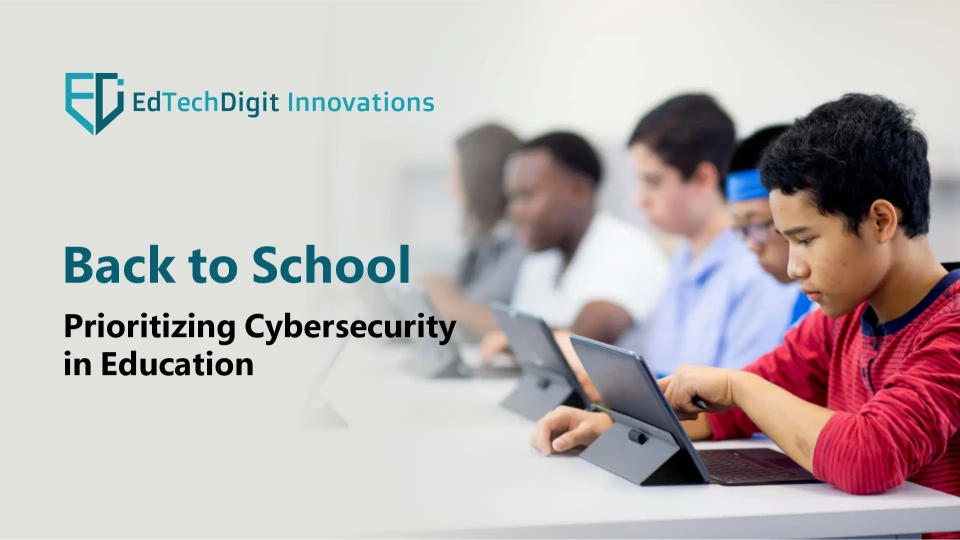As we advance through a technology-dependent world, cybersecurity in education is special rather than optional. Since technology now plays such a prominent role in, and in many cases, is the main function of the learning environment, schools and universities have become prime targets of cybercriminals. So, schools and universities are not prepared. Forbes states that only 14% of schools require security awareness training, and only 13% offer it as an option. That does not leave many students prepared to deal with online threats. These gaps in preparedness are worsened when you consider that many educational institutions have limited budgets, outdated infrastructure, and store extensive sensitive student data.
As a result, the consequences of the gaps in preparedness for cybersecurity range from data breaches and stolen finances to the disruption of learning and student safety. To mitigate such a growing concern, education stakeholders must regard cybersecurity with the degree of urgency and seriousness it needs.
The Critical Role of Cybersecurity in Education
Cybersecurity is an important factor across K–12 schools and higher education institutions. A strong cybersecurity framework protects the following vital areas of the digital ecosystem. These areas include:
- Data Security: Protect sensitive student records, personal information, and research information from unauthorized access.
- Safe Learning Environments: Protect students from cyberbullying and dangerous content.
- Network Protection: Maintain the integrity of the institution's IT infrastructure and protect against breaches.
- Reputation Protection: Protect against the reputational fallout of breaches that appear in the news.
- Compliance: Protect against privacy laws and reduce legal exposure.
Integrating cybersecurity from the ground up is one way that schools can protect trust while enabling a safe, inclusive, digital learning environment.
Why Cybercriminals Target Education Providers
Cybercriminals are drawn into the education space because:
- Outdated Security Systems—Legacy architecture often lacks modern security systems.
- Valuable Data—The stakes are high, from exam results and personal information to research and financial records.
- Underfunded Budgets—Many institutions simply cannot afford enterprise-level security.
Notable Cyber Threats in the Education Sector
|
Threat Type |
Impact on Education |
|
Ransomware & Malware |
Encrypts critical files and demands ransom; universities may pay heavily to regain access. |
|
DDoS Attacks |
Disrupts systems during exams or registration periods, affecting learning. |
|
Insider Threats |
Includes unauthorized access by students or staff, altering grades or leaking data. |
|
Phishing |
Deceives users into providing sensitive info; remains the most common threat type. |
Impact of Cyber Threats in Education
The impacts of cyberattacks across the education system are significant. Ransomware can completely shut down organizations, blocking access to key learning management systems. Distributed denial-of-service attacks (DDoS) can disrupt classes and exams, while phishing, or insider attacks, can impact the data and trust; once an account is compromised, the systems associated with that account are also vulnerable to unauthorized use, leaving all operations and services vulnerable to adverse use. This can lead to several significant administrative issues, reputational damage to the organization, as well as student safety.
Strengthening Cybersecurity: Practical Strategies
To provide an effective defense to the growing loom of threats, educational institutions should adopt proactive security measures:
- Develop a Cybersecurity Framework: Create an information security management system (it is advisable to consult standards such as ISO 27001).
- Conduct Risk Assessments: Continuously evaluate systems and users' behaviors for vulnerabilities.
- Use Access Control & Multi-Factor Authentication: Use appropriate verification and limited access to those who are not authorized.
- Increase Awareness: Train staff and students on phishing, social engineering, and how to handle data.
- Keep Systems Up To Date: Patch old systems by fixing exploitable weaknesses.
- Use External Cybersecurity Advisors: Engage with professionals from IT security companies and consultants to support institutional objectives.
- Defense in Depth: Use the suite of tools—firewall, endpoint protection, secure remote access, and continuous monitoring to improve resilience.
Technology Solutions to Enhance Protection
Good cybersecurity in education requires sustainable and scalable solutions. When approaching cybersecurity, educational institutions should prioritize
- Network Encryption and VPNs: Protect data transfer and communications.
- Role Based Access Controls: Ensure users access information only related to their role.
- Secure Remote Access: Limit off campus access to systems and data in a secure way.
- Web and DNS Filtering: Monitor and block malicious content and websites.
- Traffic Monitoring & Protocol Filtering: Determine and stop unauthorized usage of network resources.
Using a layered defense strategy in a program imprints a better security solution and complies with any data privacy requirements.
Pro Tips for Strengthening Educational Cybersecurity
For Institutions:
- Provide staff training and infrastructure.
- Conduct regular audits and penetration tests.
- Enforce data governance policies.
For Individuals:
- Use strong, unique passwords.
- Recognize phishing emails.
- Keep personal devices and apps up to date.
Regardless of whether you are implementing secure systems or arming individuals with knowledge, coordination and effort across all levels of the institution will be necessary.
Conclusion
The digital transformation of education has ushered in an age of innovation and risk. As the sophistication of threats grows, the business of protecting students, staff, and sensitive data is no longer a technical issue; it is an institutional concern. Schools and universities have to make the leap from reactive remediation to proactive cybersecurity and embrace it as a part of education today. With the right plan, understanding, and tools, education can go from an easy target to an example of digital resilience. After all, in an age driven by data, protection of education is not just about the technology; it's about protecting the future of learning.

